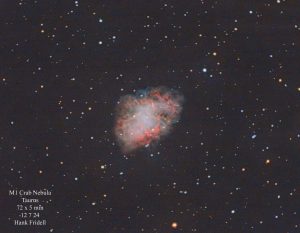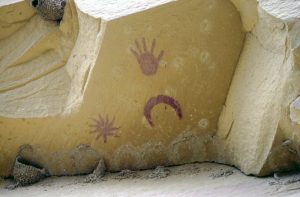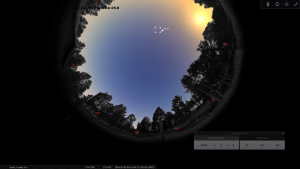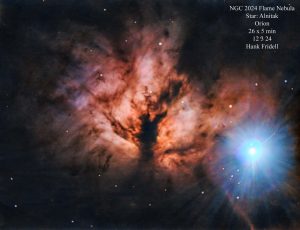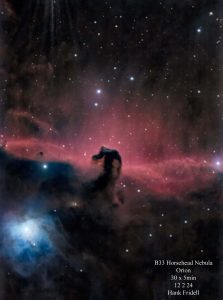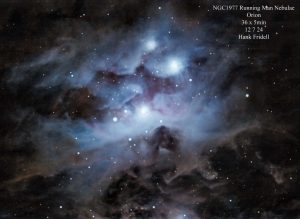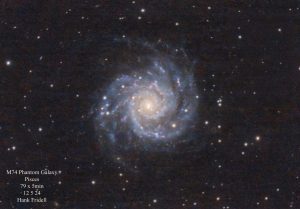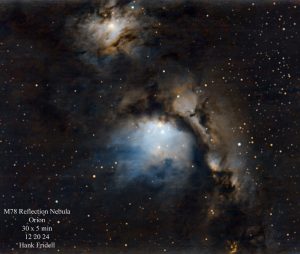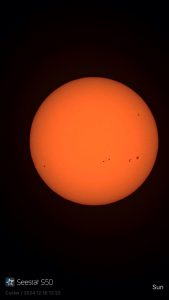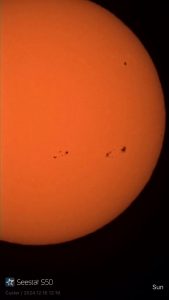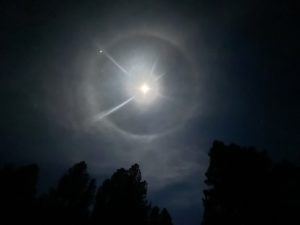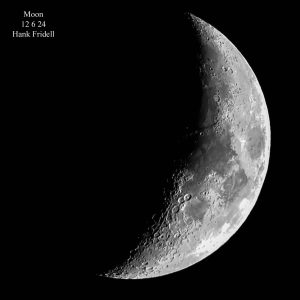Welcome to Hank’s December 2024 Astrophotography Blog. M1, the Crab Nebula, is a remanent of a supernova explosion, that I love to image. It has interesting “spaghetti” arms that surround the nebula, and my long exposure images are starting to show those features better. The M1 supernova is believed to have been documented by Chinese astronomers on July 5, 1054. It could have very well have been bright enough to be seen during the day. This date could also correspond to what is believed to be a pictograph of this supernova explosion seen from Chaco Canyon National Park, near the four corners region in New Mexico. In 1054 the Anasazi people occupied this area and may have recorded the supernova event on a wall of their canyon home, shown in the photo below. I took a planetarium screen shot using a sky map app, Stellarium, and it shows what the sky looked like on July 5, 1054 at about 5:30 in the morning, showing that as the Sun was rising, the Moon and M1 (centered where the box is next to the Moon) were in close proximity together, and in the same positional relationship as in the pictograph. The moon was also a waning crescent on that morning, much like the pictograph. Interesting to think that after nearly a thousand years, we have evidence that people on opposite sides of the Earth witnessed the same cosmic event. At the center of M1 is a pulsar, a rotating neutron star, that is spinning around every 33 milliseconds, emitting powerful X, gamma and radio rays. M1 is about 13 light years across (76,422,129,851,387 miles, plus or minus a few trillion miles!) and continues to expand at at a rate of about 930 miles per second. It is about 6,300 light years from Earth.
NGC2024, the Flame Nebula, is about 1350 light years from Earth. It has a bright blue star by it, Alnitak. Alnitak is actually a triple star system about 1260 light years from Earth, or about 90 light years closer to us than the Flame Nebula. The distance between the two is enough that they are not associated with one another, other than to be in our same field of view. Alnitak is a blue supergiant, and is estimated to be 33 times more massive, with a diameter 20 times greater, and 21,000 times brighter than our Sun. It is the brightest star of its class in the night sky. Astronomers believe that in about a million years it will expand into a red supergiant, wider than the orbit of Jupiter before exploding into a supernova, likely leaving a black hole behind. Close to the Flame Nebula in Orion is the Horsehead Nebula. The dark horse head is really a dust/gas cloud that is blocking the light of the stars behind it. Also shown is another Orion dark nebula, the Running Man, NGC 1977.
The last few months, as I have been collecting more and more hours of exposure of some targets in the sky, I have been working on my post processing skills using the apps Siril, GraXpert and Photoshop Elements. M74, the Phantom Galaxy that I have posted many times before, is one that I have processed about a dozen times this month, trying to tweak out a little more detail each time. Here is my latest…but I’ll probably continue to keep working on it.
You’ll be seeing more of M78 (Casper the Ghost Nebula) from me in the coming months. Astrophotographers from our Black Hills Astronomical Society have chosen this target to image for the next 3 months so we can combine the hours of capture to create a very detailed image, much like we did this last fall with the Ghost Nebula. This image represents two and a half hours of capture time.
Sun: I’ve been taking photos of the Sun this winter with my SeeStar telescope, checking out the sunspot activity. When these solar storms erupt in the right spot, it means we might be getting the Aurora Borealis, or Northern Lights, down in our area. There is a great website hosted by the Space Weather Prediction Center that shows tonight and tomorrow night’s Aurora forecast, and other cool Aurora information. Check it out:
https://www.swpc.noaa.gov/communities/aurora-dashboard-experimental
Finally, on the 12th I stepped outside in the evening to see what was in the sky, and there was a great halo around the Moon, with Jupiter nearby. This photo was taken with my iPhone. These halos are caused by ice crystals in the sky reflecting the Moon’s glow. Also shown is a photo of the waxing Moon taken about a week earlier.
Until next time, Clear Skies! -Hank




